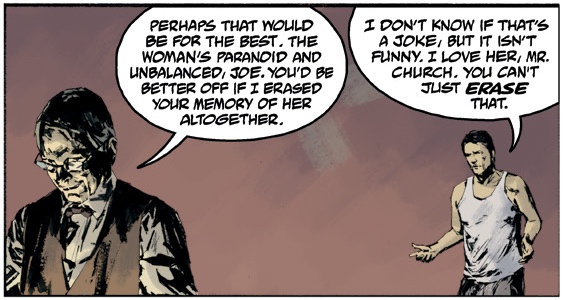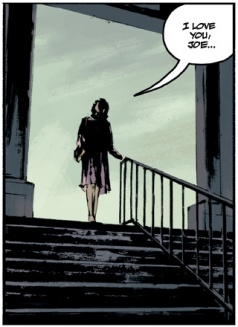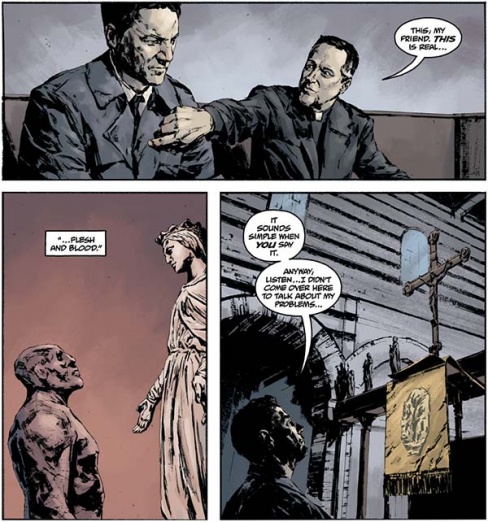
On Wednesday “Joe Golem, Occult Detective: Flesh and Blood” #1 came out, the first of a two-part arc from Mike Mignola, Christopher Golden, and Patric Reynolds. With our recent retrospective series, we’ve already delved into the writing side of things, but I wanted to take some time to delve into Reynolds’s art on the series. Read on for the interview below.
If you missed our four-part Mignolaversity retrospective, here’s some handy links:
∙ Part 1: “Hellboy”
∙ Part 2: “B.P.R.D. The Devil You Know” & “Hellboy and the B.P.R.D.”
∙ Part 3: The Expanding Hellboy Universe
∙ Part 4: Beyond the Hellboy Universe
It’s been an interesting year for “Joe Golem, Occult Detective.” In the three-issue arc, “The Outer Dark,” humans managed to draw attention from beyond the veil of the world, which, as readers of Joe Golem and the Drowning City will know, is going to have some pretty major consequences.
Patric Reynolds: Definitely. I loved the fact that I got to delve a little more into the more nefarious characters of the Joe Golem universe in “The Outer Dark” issues, and hint at some of their actions that will drive the narrative in other stories. And it’s interesting that the supernatural elements in “Joe Golem” are a little more indirect and subtle, and their origins are hinted at with short flashbacks and single panels with shadowy, menacing shapes and forms.

I think that this helps create a sense of tension and dread of the unknown for the reader, so that when these forces do get unleashed it has more of an poignant impact. Its evil magic that’s a little more on the periphery of the story and action and when it finally gets released it twists and alters the effects the seemingly normal things that are already there.’
The latest “Joe Golem” arc began this week with “Flesh and Blood” #1. In the previous arc, “The Outer Dark,” Mr. Church was shown erasing no just Joe’s memories, but Lori’s too, effectively trapping the pair of them in a limbo relationship that can never evolve past a certain point. In “Flesh and Blood” #1, we see the toll this is having on both of them.
Christopher Golden: Simon Church truly believes he has Joe’s best interests at heart. But subconsciously, he knows that he’s taken it too far, and that part of his motivation is selfish. It’s making him do shitty things.


It’s interesting that you mentioned that Joe and Lori become trapped in “limbo,” because I think that people get trapped in relationship limbo without strange supernatural things conspiring against them in real life. From all that I’ve read from Chris’s scripts from the comic and in the novel, I got the sense that Joe isn’t real good at intimate relationships after a certain point, and eventually (and probably instinctively) would put up defensive emotional barriers to protect himself and the ones he cares about from the horrors of his profession. I thought that there must be more to Joe’s failure at relationships simply being the result of Church’s interventions, and there had to be pretty deep-seeded flaws with Joe, too.
I challenged myself to try and hint at that visually, even if it wasn’t more directly alluded to in the script. So in later issues, I started depicting Joe adopting more defensive gestures (arms folded, not directly facing other characters who he is talking to, etc.), and making him feel more isolated and alone by surrounding him with more negative space. I even went so far as to re-use panels in previous issues where Joe and Lori or Joe and Church would be talking, but then taking Lori or Church out the shot and making very minor background adjustments to suggest a passage of time. I think readers get a pretty good sense that Joe is emotionally closed off in the novel, but when they read the comics, they may get a little more in-depth exploration as to why he is, and also why he’s so still so beholden to Church.
Continued below
You use a lot of photo reference in your work, to the point that you even cast the roles. In the case of Joe Golem, you don’t just draw him, you are him. I’m curious how you feel about Joe Golem given that his face is based on your own.
Patric: No matter project I’m doing, it is impossible to separate myself from it. They’re such a ridiculous emotional and physical investment on my part into everything that I do, and I think “Joe Golem” shows that pretty overtly.
The main reason why I used myself as a model for Joe is that I needed someone who had to be available a lot, and my own face was pretty much available at any time. I also know my own face better than anyone else’s—I could get the facial expressions I wanted and it is much easier to direct myself than it is other people. But, Joe and I are very different physically, so I’ve had to add scars, a bigger nose, much better hair, and a much more severe countenance that would lead to a lot more furrowed brows and clenched jaws. It’s like Joe is always preparing himself to take a punch to the face.

That being said, all of the models that I used were absolutely incredible to work with and a lot of the emotional resonance in the “Joe Golem” series comes from their grace. They are all acting for reference photos in what amounts to a very amateur theater production of sorts, sometimes while wearing old bathrobes in my tiny studio apartment that serves as a ‘stage’ that’s lit with reappropriated desk lamps and furnished with laundry hampers covered with blankets to simulate cafe tables or altars used in the Spanish Inquisition. I hope that the fact that characters are based on real people with unique mannerisms and expressions makes them more resonant and that it deepens the emotional connection between them and the reader.
Before each photo shoot, I write down a ‘shot list’ that details all of the shots I need to get for each session (I try to keep it about twelve shots per session so that I don’t take up more than about forty-five minutes to an hour of my model’s time). Each shot is noted with lines of dialogue, acting notes (like ‘giving the WORST STINK EYE IN HISTORY EVER’) and the nature of the light source (like ‘LIT from slightly above and to the RIGHT’). I usually only shoot one model at a time (unless there’s a fight scene or an interaction where the characters are actually touching each other), only because it just becomes too hard to work around more than one person’s schedule and get a group together. But I’ve found that I can splice other images of models together in a single shot in Photoshop (with each actor on a different layer) and establish a roughly accurate spatial relationship between them, as long as I know where the horizon line and vanishing points are.
I keep thinking that I’m asking a lot out my models to do this for me, and I’m actually kind of shocked that they thank me for letting them be a part of all this. It’s also an excuse to spend time with my friends and maintain relationships with them, especially when the time constraints of my work schedule doesn’t always allow for a lot of interaction with people.
I particularly liked the scene at Saint Gerard’s, the way you married a moment from the past to the present.
Patric: Thank you! Those scenes where Joe is having a ‘heart to heart’ with another character, like with Church or (in the case that you mentioned) Father Ryan, are some of my favorites too… If I can nail the nuances of the character interactions, the scene has the potential to be very emotionally resonant.

In “Flesh and Blood” #1, it’s pages 6 and 7 that do it for me—it’s the flashback scene where the golem is rescuing the little girl from the nasty witches and then delivers her back to her very worried parents. The golem had to be a savage and brutal force of nature but also very kind, delicate, and protective the span of a very few panels. The emotional range the golem had to exhibit was wider than it was at any other time in the whole series. I like how Chris wrote that scene in a way that focused not on the action of the fight scene, but rather the moment when the golem becomes the most ‘human.’
Continued belowThere wasn’t a whole lot of dialogue in that sequence, so the facial expressions and nuances had carry a lot the weight and I really had to get them right—from the joy on the girl’s face to the confusion and shock in the parent’s faces as this primordial thing passes their child back to them with his huge hands. I really think the emotional arc of the golem and Joe himself can neatly be encapsulated in that scene, and it served as a nice little affirmation of what “Joe Golem” has brought to the Mignolaverse. And if that scene succeeds I owe a lot of that to the models who posed for it. I purposefully chose my friend (and fantastic Dark Horse editor) Spencer Cushing, his wife Diana, and their daughter Hazel because I knew their close familial bond and all the emotions that come with it would be easy for them to project.
I understand this arc is your last for “Joe Golem” Are there any particular favourite moments you have had working on this series?
Patric: My Dad taught me a little bit about how to work on cars when I was growing up, and I got a lot of practice on my first car (a 1981 Toyota Celica… with a sunroof!). He wanted me to teach me how to figure things out instead of relying on others to solve problems for me. I remember having to replace the starter motor one summer, and after hours spent toiling underneath that old rig and getting my hands all greasy and nicked up I finally got the damn car to start—there was nothing more empowering than hearing that thing finally fire up.
This is why “Joe Golem” was so important to me, and why my favorite moments were ones where I was wondering ‘How in the hell am I going to do THAT??!?!’ When I figured them out it was like hearing that ignition fire for the first time.
“Joe Golem, Occult Detective: Flesh and Blood” #2 comes out January 31.

Written by Mike Mignola and Christopher Golden
Illustrated by Patric Reynolds
Colored by Dave Stewart
Lettered by Clem RobinsThere’s much more than meets the eye in the haunted house Joe investigates, and Joe’s personal troubles get more serious.









